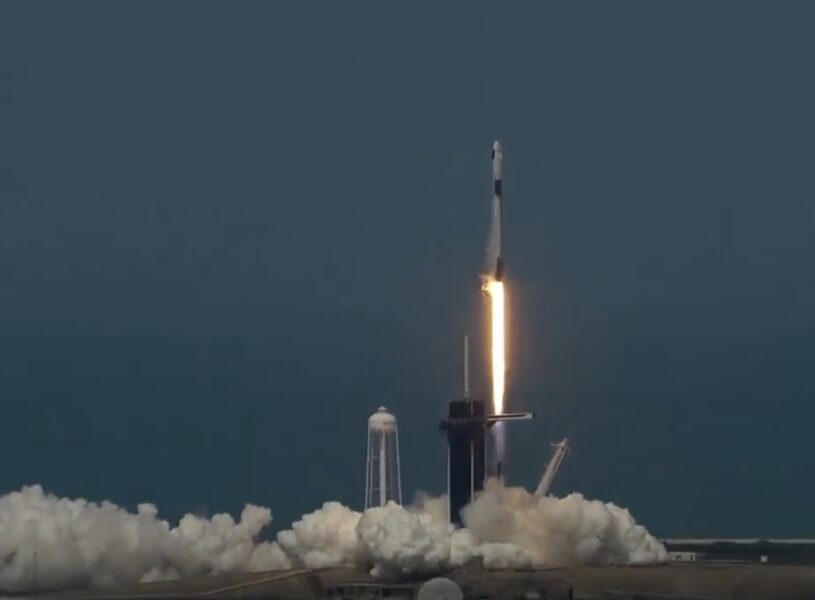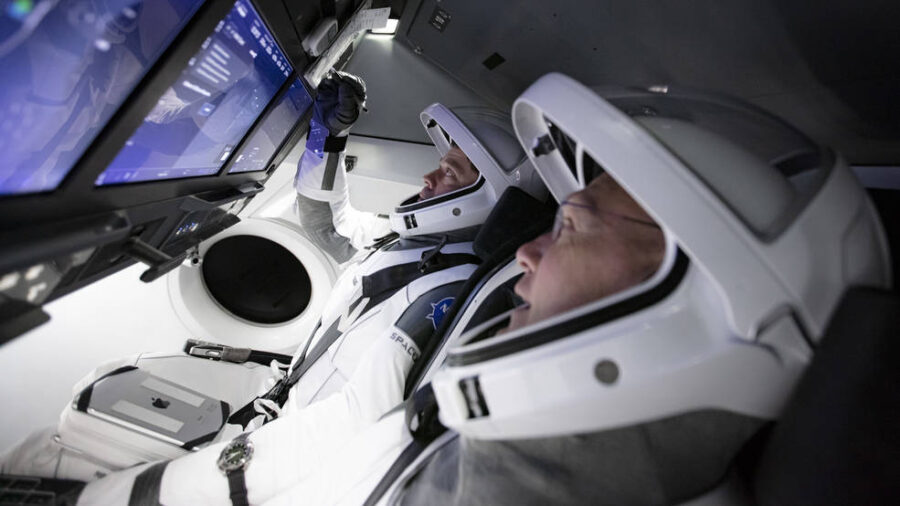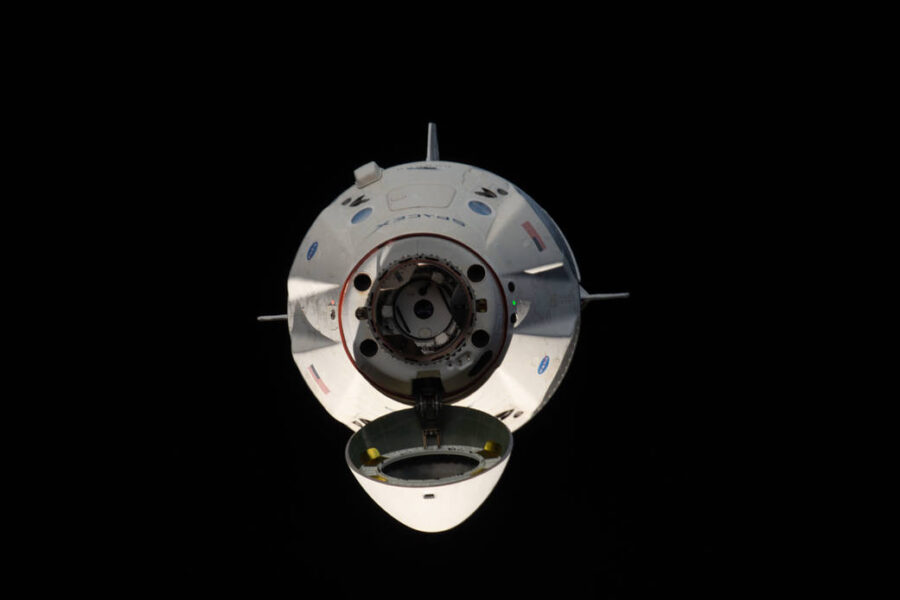Crewed spaceflight returns to U.S. soil, with the successful launch of Crew Dragon Demo 2.

NASA
One of the most anticipated missions in human spaceflight occurred today, when a SpaceX Falcon 9 rocket roared to life at the Kennedy Space Center’s launch complex 39A with the new Crew Dragon capsule on its second demonstration mission — and its first flight carrying crew. Liftoff occurred on Saturday, May 30th at 3:22 p.m. EDT/19:22 UT. This marks the first launch from American soil since the retirement of NASA's space shuttle program in 2011.
"I've heard that rumble before, but it's a whole different feeling when you've got your own team on that rocket," says NASA administrator Jim Bridenstine. "They are our team. They are America's team."
The crew consists of NASA astronauts Robert Behnken and Douglas Hurley, both space shuttle veterans. Their mission parameters were nominal from liftoff to low-Earth orbit. The Falcon 9 first stage booster also landed successfully on the Of Course I Still Love You platform in the Atlantic, just over nine minutes after liftoff.
Demo 2 is meant to put the new Dragon spacecraft through its paces before the launch of the first operational/contracted mission, USCV-1 (U.S. Crew Vehicle-1) slated for August 30, 2020. That mission will carry four crew members. Though the Crew Dragon capsule has a seating capacity of seven, NASA only intends to seat four astronauts on later scheduled missions to the International Space Station (ISS).

NASA / SpaceX
“I don’t have to tell you all how exciting it is to have the first flight of humans to space from the Kennedy Space Center in nine years,” says Kennedy Space Center director Bob Cabana (NASA) in a recent blog post. “Now, rather than rusting away in the salt air, through our partnership with SpaceX that pad is being used once again, and it’s now for our Commercial Crew Program as well as other missions for SpaceX, and I think that’s absolutely outstanding.”
The launch was carried out with limited in-person media activities, due to the ongoing worldwide pandemic. Those journalists and photographers that did attend took precautions, including physical distancing and wearing face masks.
The historic launch was to occur on Wednesday, May 27th, but was scrubbed due to weather violation constraints along the Atlantic launch track. This would have been 15 years to the day since the very first static fire test of SpaceX’s Falcon 1 rocket. It also marks the return of crewed spaceflight to U.S. soil, an era that ended on July 21, 2011, with the final landing of the U.S. Space Shuttle Atlantis on STS-135 nearly nine years ago. (Hurley actually also piloted STS-135.) This span of time was longer than that between the final Apollo mission (the Apollo-Soyuz Test Project in July 1975) and the launch of space shuttle Columbia on STS-1 in April 1981.
Since 2011, NASA has relied on Russia’s Soyuz spacecraft to bring crew to the ISS, at a cost of $81 million a seat. NASA’s Commercial Crew Transportation Capability contract awarded SpaceX and Boeing $2.6 billion and $4.2 billion, respectively, for each company to fly an uncrewed and crewed demonstration mission, followed by six operational missions each to the ISS. SpaceX will carry out its assigned missions though 2021. Boeing launched and landed an uncrewed Starliner capsule in late 2019, but it failed to reach the space station. The company will carry out a second uncrewed demo flight in the fall.

NASA
On March 3, 2019, SpaceX's automated Crew Dragon Demo 1 flight successfully arrived at the station, then splashed down in the Atlantic five days later. Demo 2 will arrive at the ISS and dock at the forward point on the Harmony module at 14:29 UT (10:29 a.m. EDT) on Sunday, May 31st. Hurley and Behnken will spend four months at the station before returning to Earth on September 23, 2020. That landing will also be a splashdown — although the Crew Dragon was originally equipped with retro-rockets to touchdown on landing, similar to Russia’s Soyuz capsule, engineers opted for water landings due to safety concerns.
The vintage NASA worm logo has come back for this occasion, adorning the fuselage of the SpaceX Falcon 9 rocket (right click for full image):
Tomorrow, @AstroBehnken & @Astro_Doug become the 1st humans to launch to the @Space_Station from American soil since the final space shuttle mission in 2011. Don’t miss our live coverage, including video from the @SpaceX Crew Dragon spacecraft!
Details: https://t.co/McKRZTW8rs pic.twitter.com/4CX64mc18f
— NASA (@NASA) May 26, 2020
The mission is not without its risks. Challenger and Columbia were lost during the U.S. Space Shuttle program, and NASA later calculated the risk of the program at its conclusion as 1-in-90. During the final flight review of Demo 2, NASA put the risk of mission failure with loss of crew at 1-in-276, meeting the now more stringent threshold of 1-in-270. Crew Dragon has an escape abort system similar to Apollo that would carry the capsule and crew clear of the rocket in the event of an emergency using its Super Draco thrusters. This was tested twice in dramatic fashion at Cape Canaveral during a ground abort test in 2015, and a flight test in which a Falcon 9 rocket was deliberately destroyed in 2019. The spacecraft could even make an automated return to Earth in the event the crew is incapacitated. This would also mean a water landing somewhere along the Atlantic launch track, another reason that weather needs to be reasonably calm not only at the launch site, but along the swath of ocean beneath the track.
U.S. Air Force pararescue teams out of Patrick Air Force Base in Florida, Charleston AFB South Carolina and Hickam AFB in Hawaii are on standby worldwide to rescue the crew if needed, and will remain so until Crew Dragon is docked to the ISS.
This launch follows recent internal turmoil at NASA, as the head of human spaceflight Doug Loverro resigned last week, just days prior to the final flight review for Crew Dragon. Loverro has stated that his resignation was unrelated to this launch. Even though NASA and Loverro failed to give a specific reason for the abrupt resignation, speculation in the spaceflight industry procurement issues related to NASA’s accelerated Artemis program, which aims to return humans to the Moon by 2024.
Tonight also offers a good chance to see Crew Dragon for yourself. If skies are clear, the northern contiguous United States and Canada should have multiple passes at dusk. If you have a scheduled ISS pass tonight, you have a chance at spying Dragon in orbit. Heavens-Above also has a Crew Dragon tracking link on their front page. Crew Dragon launched eight minutes behind the International Space Station on its 93-minute orbit around the Earth.
It's exciting to see crew depart from the Florida Space Coast once again, though it's a bit surreal seeing astronauts ride to the launch pad in Tesla-branded roadsters, adorned with NASA logos. Is the continued commercialization of space a good thing? It’s an interesting time for sure, as NASA guides private companies and crew to a brave new era of human spaceflight in low-Earth orbit.
 1
1









Comments
Jim
June 3, 2020 at 2:05 pm
Thank you so much for this article. It is exciting to see manned launches again from the US. My family and I watched Crew Dragon orbit the earth from our backyard followed close behind by the ISS! Thank you also for keeping politics out of science as it should be!
You must be logged in to post a comment.
You must be logged in to post a comment.